This article has multiple issues. Please help improve it or discuss these issues on the talk page . (Learn how and when to remove these template messages)
|
Jan Peter Toennies (born 3 May 1930) is a German-American scientist.
This article has multiple issues. Please help improve it or discuss these issues on the talk page . (Learn how and when to remove these template messages)
|
Jan Peter Toennies (born 3 May 1930) is a German-American scientist.
He was born in Philadelphia, Pennsylvania on 3 May 1930 to German immigrant parents. [1] He is the grandson of sociologist Ferdinand Tönnies.
He graduated from Lower Merion High School, outside of Philadelphia, in 1948. He went on to Amherst College, where he finished with a BA in 1952, and to Brown University, where he received a PhD in chemistry in 1957. During graduate school he was a Fulbright student in Göttingen 1953–1954. [1]

Raman spectroscopy is a spectroscopic technique typically used to determine vibrational modes of molecules, although rotational and other low-frequency modes of systems may also be observed. Raman spectroscopy is commonly used in chemistry to provide a structural fingerprint by which molecules can be identified.

Spartan is a molecular modelling and computational chemistry application from Wavefunction. It contains code for molecular mechanics, semi-empirical methods, ab initio models, density functional models, post-Hartree–Fock models, and thermochemical recipes including G3(MP2) and T1. Quantum chemistry calculations in Spartan are powered by Q-Chem.
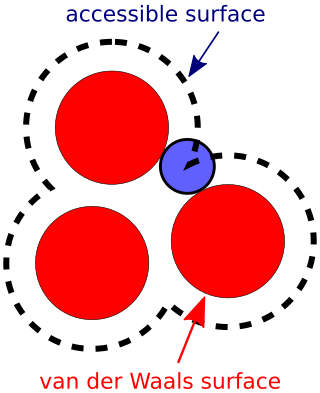
The accessible surface area (ASA) or solvent-accessible surface area (SASA) is the surface area of a biomolecule that is accessible to a solvent. Measurement of ASA is usually described in units of square angstroms. ASA was first described by Lee & Richards in 1971 and is sometimes called the Lee-Richards molecular surface. ASA is typically calculated using the 'rolling ball' algorithm developed by Shrake & Rupley in 1973. This algorithm uses a sphere of a particular radius to 'probe' the surface of the molecule.
The fragment molecular orbital method (FMO) is a computational method that can be used to calculate very large molecular systems with thousands of atoms using ab initio quantum-chemical wave functions.
This page deals with the electron affinity as a property of isolated atoms or molecules. Solid state electron affinities are not listed here.
Giacinto Scoles is a European and North American chemist and physicist who is best known for his pioneering development of molecular beam methods for the study of weak van der Waals forces between atoms, molecules, and surfaces. He developed the cryogenic bolometer as a universal detector of atomic and molecule beams that not only can detect a small flux of molecules, but also responds to the internal energy of the molecules. This is the basis for the optothermal spectroscopy technique which Scoles and others have used to obtain very high signal-to noise and high resolution ro-vibrational spectra.

Molecular Dynamics of Mixtures (MDynaMix) is a computer software package for general purpose molecular dynamics to simulate mixtures of molecules, interacting by AMBER- and CHARMM-like force fields in periodic boundary conditions. Algorithms are included for NVE, NVT, NPT, anisotropic NPT ensembles, and Ewald summation to treat electrostatic interactions. The code was written in a mix of Fortran 77 and 90. The package runs on Unix and Unix-like (Linux) workstations, clusters of workstations, and on Windows in sequential mode.

Ascalaph Designer is a computer program for general purpose molecular modelling for molecular design and simulations. It provides a graphical environment for the common programs of quantum and classical molecular modelling ORCA, NWChem, Firefly, CP2K and MDynaMix . The molecular mechanics calculations cover model building, energy optimizations and molecular dynamics. Firefly covers a wide range of quantum chemistry methods. Ascalaph Designer is free and open-source software, released under the GNU General Public License, version 2 (GPLv2).
The Holstein–Herring method, also called the surface Integral method, or Smirnov's method is an effective means of getting the exchange energy splittings of asymptotically degenerate energy states in molecular systems. Although the exchange energy becomes elusive at large internuclear systems, it is of prominent importance in theories of molecular binding and magnetism. This splitting results from the symmetry under exchange of identical nuclei. The basic idea pioneered by Theodore Holstein, Conyers Herring and Boris M. Smirnov in the 1950-1960.

Michele Parrinello is an Italian physicist particularly known for his work in molecular dynamics. Parrinello and Roberto Car were awarded the Dirac Medal of the International Centre for Theoretical Physics (ICTP) and the Sidney Fernbach Award in 2009 for their continuing development of the Car–Parrinello method, first proposed in their seminal 1985 paper, "Unified Approach for Molecular Dynamics and Density-Functional Theory". They have continued to receive awards for this breakthrough, most recently the Dreyfus Prize in the Chemical Sciences and the 2021 Benjamin Franklin Medal in Chemistry.
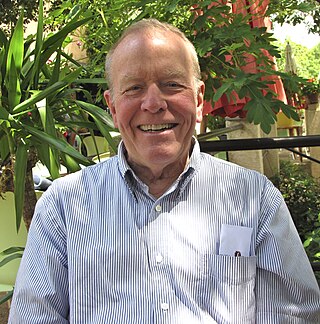
James Bernhard Anderson was an American chemist and physicist. From 1995 to 2014 he was Evan Pugh Professor of Chemistry and Physics at the Pennsylvania State University. He specialized in Quantum Chemistry by Monte Carlo methods, molecular dynamics of reactive collisions, kinetics and mechanisms of gas phase reactions, and rare-event theory.
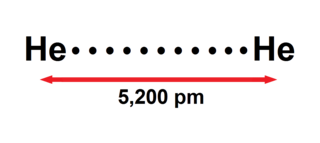
The helium dimer is a van der Waals molecule with formula He2 consisting of two helium atoms. This chemical is the largest diatomic molecule—a molecule consisting of two atoms bonded together. The bond that holds this dimer together is so weak that it will break if the molecule rotates, or vibrates too much. It can only exist at very low cryogenic temperatures.
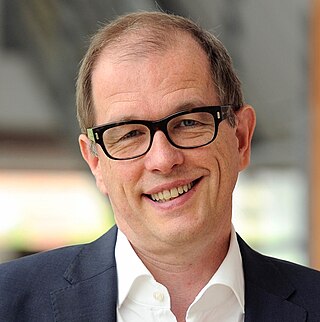
David Lyndon Emsley FRSC is a British chemist specialising in solid-state nuclear magnetic resonance and a professor at EPFL. He was awarded the 2012 Grand Prix Charles-Leopold Mayer of the French Académie des Sciences and the 2015 Bourke Award of the Royal Society of Chemistry.
Takeshi Oka,, is a Japanese-American spectroscopist and astronomer specializing in the field of galactic astronomy, known as a pioneer of astrochemistry and the co-discoverer of interstellar trihydrogen cation . He is now R.A. Milliken Distinguished Service Emeritus Professor, Departments of Astronomy and Astrophysics, Chemistry; Enrico Fermi Institute; and the College of University of Chicago.

Martin Quack is a German physical chemist and spectroscopist; he is a professor at ETH Zürich.

Biman Bagchi is an Indian scientist currently serving as a SERB-DST National Science Chair Professor and Honorary Professor at the Solid State and Structural Chemistry Unit of the Indian Institute of Science. He is a theoretical physical chemist and biophysicist known for his research in the area of statistical mechanics; particularly in the study of phase transition and nucleation, solvation dynamics, mode-coupling theory of electrolyte transport, dynamics of biological macromolecules, protein folding, enzyme kinetics, supercooled liquids and protein hydration layer. He is an elected fellow of the Indian National Science Academy, the Indian Academy of Sciences, The World Academy of Sciences and an International honorary member of the American Academy of Arts and Sciences. Along with several scientific articles, he has authored three books, (i) Molecular Relaxation in Liquids, (ii) Water in Biological and Chemical Processes: From Structure and Dynamics to Function, and (iii) Statistical Mechanics for Chemistry and Materials Science.

Bretislav Friedrich is a Research Group leader at the Department of Molecular Physics, Fritz-Haber-Institut der Max-Planck-Gesellschaft and Honorarprofessor at the Technische Universität in Berlin, Germany. He is globally recognized for his pioneering research surrounding interaction of molecules with and in electric, magnetic, and optical fields as well as on cold molecules. He was admitted to the Learned Society of the Czech Republic in 2011.
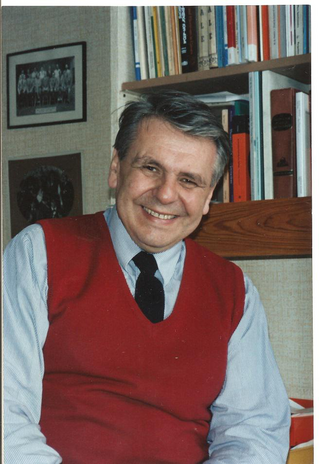
Zdeněk Herman was a Czech physical chemist.

William Michael Gelbart is Distinguished Professor of Chemistry and Biochemistry at the University of California, Los Angeles, and a member of the California NanoSystems Institute and the UCLA Molecular Biology Institute. He obtained his Bachelor of Science degree from Harvard University in 1967, his Master's (1968) and PhD (1970) degrees from the University of Chicago, and did postdoctoral work at the University of Paris (1971) and the University of California, Berkeley (1972). After 30 years of research in theoretical physical chemistry, contributing notably to the fields of gas-phase photophysics, optical properties of simple liquids, and the statistical physics of complex fluids, he started a biophysics laboratory with Charles Knobler in 2002 to investigate the physical aspects of viral infectivity.
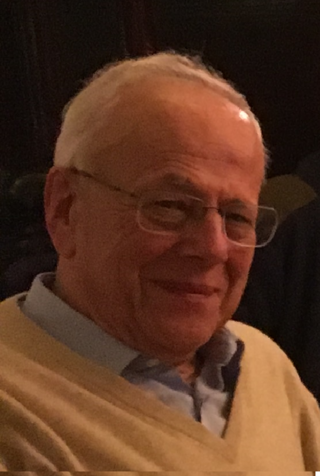
Giorgio Benedek is an Italian physicist, academic and researcher. He is an Emeritus Professor of Physics of Matter at University of Milano-Bicocca and Director of the International School of Solid State Physics at Ettore Majorana Foundation and Centre for Scientific Culture.